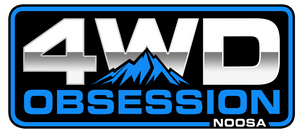Introduction
When it comes to off-roading and overlanding, having a reliable and efficient power system is crucial. Whether you're running a fridge, lighting, or other accessories, a 12V control hub with a DCDC charger can make all the difference. In this blog, we'll dive into what these systems are, why they're essential for any serious 4WD enthusiast, and how to choose the best setup for your needs.
What is a 12V Control Hub with a DCDC Charger?
A 12V control hub is a centralized system that manages all your vehicle's electrical accessories. It allows you to control and monitor various devices from a single point, making it easier to manage power consumption and ensure everything runs smoothly. When paired with a DCDC charger, it becomes a powerhouse of efficiency, ensuring your auxiliary battery is charged safely and effectively.
Key Components:
- 12V Control Hub: The heart of your vehicle's electrical system, providing control over various accessories.
- DCDC Charger: A device that efficiently charges your auxiliary battery from the vehicle's alternator, solar panels, or other power sources.
Benefits of Using a 12V Control Hub with a DCDC Charger
1. Efficient Power Management: A 12V control hub allows you to monitor and manage your power usage effectively. With all accessories centralized, you can easily keep track of what’s drawing power and make adjustments as needed.
2. Reliable Battery Charging: A DCDC charger ensures your auxiliary battery is charged correctly, protecting it from overcharging or undercharging. This is especially important when using high-demand accessories like fridges and lighting systems.
3. Simplified Wiring: Having a control hub simplifies the wiring process, reducing clutter and potential points of failure. This makes for a cleaner, more reliable setup.
4. Enhanced Safety: With features like low voltage disconnect and circuit protection, a 12V control hub enhances the safety of your electrical system, preventing damage to your accessories and vehicle.
5. Versatility: Many control hubs and DCDC chargers are compatible with a variety of power sources, including solar panels. This versatility ensures you can keep your system running efficiently, no matter where you are.
How to Choose the Right 12V Control Hub and DCDC Charger
1. Power Requirements: Consider the power demands of your accessories. Make sure the control hub and DCDC charger can handle the combined load.
2. Compatibility: Ensure the components are compatible with your vehicle’s electrical system and any existing accessories.
3. Ease of Installation: Look for systems that offer straightforward installation processes. Many kits come with detailed instructions and all necessary hardware.
4. Brand and Quality: Invest in reputable brands known for their quality and reliability. Brands like Redarc, Enerdrive, and Projecta are well-regarded in the 4WD community.
5. Additional Features: Consider any extra features that might be beneficial, such as remote monitoring, Bluetooth connectivity, or integration with other systems.
Popular 12V Control Hub and DCDC Charger Setups
1. Redarc Manager30: A comprehensive battery management system that includes a DCDC charger, solar regulator, and 240V charger. It’s perfect for those looking for a complete solution.
2. Enerdrive eSYSTEMs: These systems offer a modular approach, allowing you to build a setup that suits your specific needs. They’re known for their high quality and durability.
3. Projecta Intelli-Charge: A robust DCDC charger with smart features like multi-stage charging and solar compatibility, ideal for maintaining battery health.
Installation Tips
1. Plan Your Layout: Before starting, plan where each component will be installed. Ensure easy access for monitoring and maintenance.
2. Use Quality Wiring: Invest in high-quality wiring and connectors to prevent voltage drops and ensure a reliable connection.
3. Follow Instructions: Always follow the manufacturer’s installation instructions. Improper installation can lead to system failures and void warranties.
4. Test Your System: After installation, thoroughly test your system to ensure everything is working correctly. Check all connections and monitor the charging process.
Conclusion
A 12V control hub with a DCDC charger is an invaluable addition to any 4WD setup. It ensures efficient power management, reliable battery charging, and enhanced safety. By choosing the right components and following proper installation practices, you can enjoy a dependable power system that keeps your adventures running smoothly.
For more information on the best products and installation tips, visit 4WD Obsession Noosa or contact our expert team.
